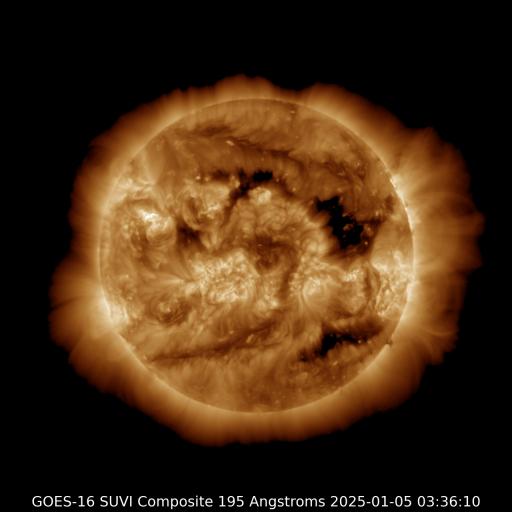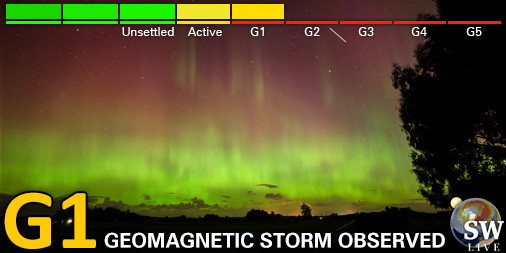Viewing archive of Friday, 22 January 2016
Daily bulletin on solar and geomagnetic activity from the SIDC
Issued: 2016 Jan 22 1230 UTC
SIDC Forecast
Solar flares
C-class flares expected, (probability >=50%)
Geomagnetism
Active conditions expected (A>=20 or K=4)
Solar protons
Quiet
| 10cm flux | Ap | |
|---|---|---|
| 22 Jan 2016 | 104 | 018 |
| 23 Jan 2016 | 103 | 013 |
| 24 Jan 2016 | 106 | 005 |
Bulletin
NOAA 2487 produced the only C-class flare of the period, a C1.4 peaking at 13:51UT. The event lasted for 57 minutes (x-ray) and was associated with a relatively narrow coronal mass ejection (CME) that was not directed to Earth. The nearby 20 degrees long north-south oriented filament remained stable. NOAA 2486 was decaying. No earth-directed CMEs were observed.
There remains a chance on an isolated C-class flare. . The earth environment remained under the influence of the high speed stream of the southern polar coronal hole (CH). Solar wind started and ended the period with a speed of around 500 km/s, meanwhile reaching a maximum speed of about 550 km/s early on 22 January (02UT-05UT). Bz undulated between -7 nT and + 6 nT, while the interplanetary magnetic field was directed towards the Sun. Mostly active geomagnetic conditions were recorded, with locally (Dourbes) minor storming during the 22-23UT interval. The extension of a northern polar CH around +25 degrees latitude is transiting the central meridian.
Mostly quiet to unsettled geomagnetic conditions are expected, with a chance on an active episode.
Today's estimated international sunspot number (ISN): 060, based on 11 stations.Solar indices for 21 Jan 2016
| Wolf number Catania | 057 |
| 10cm solar flux | 104 |
| AK Chambon La Forêt | 046 |
| AK Wingst | 037 |
| Estimated Ap | 037 |
| Estimated international sunspot number | 058 - Based on 24 stations |
Noticeable events summary
| Day | Begin | Max | End | Loc | Strength | OP | 10cm | Catania/NOAA | Radio burst types | |
|---|---|---|---|---|---|---|---|---|---|---|
| None | ||||||||||
Provided by the Solar Influences Data analysis Center© - SIDC - Processed by SpaceWeatherLive
All times in UTC
Current data suggests there is a slight possibility for aurora to appear at the following high latitude regions in the near future
NuukLatest news
Latest forum messages
Support SpaceWeatherLive.com!
A lot of people come to SpaceWeatherLive to follow the Sun's activity or if there is aurora to be seen, but with more traffic comes higher server costs. Consider a donation if you enjoy SpaceWeatherLive so we can keep the website online!

Latest alerts
00:55 UTC - Coronal hole
A southern hemisphere coronal hole is facing Earth. Enhanced solar wind could arrive in ~3 days
Monday, 7 April 2025
20:45 UTC - Geomagnetic activity
Active geomagnetic conditions (Kp4) Threshold Reached: 20:39 UTC
17:33 UTC - Hemispheric Power Index
The OVATION model predicts the Hemispheric Power Index to reach 51GW at 18:18 UTC
Sunday, 6 April 2025
02:00 UTC - Geomagnetic activity
Minor G1 geomagnetic storm (Kp5) Threshold Reached: 01:50 UTC
Space weather facts
| Last X-flare | 2025/03/28 | X1.1 |
| Last M-flare | 2025/04/05 | M1.0 |
| Last geomagnetic storm | 2025/04/06 | Kp5 (G1) |
| Spotless days | |
|---|---|
| Last spotless day | 2022/06/08 |
| Monthly mean Sunspot Number | |
|---|---|
| March 2025 | 134.2 -20.4 |
| April 2025 | 148.7 +14.5 |
| Last 30 days | 134.1 -5.6 |





